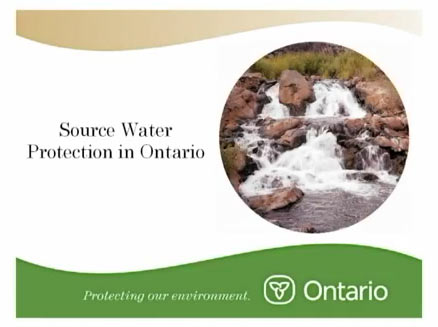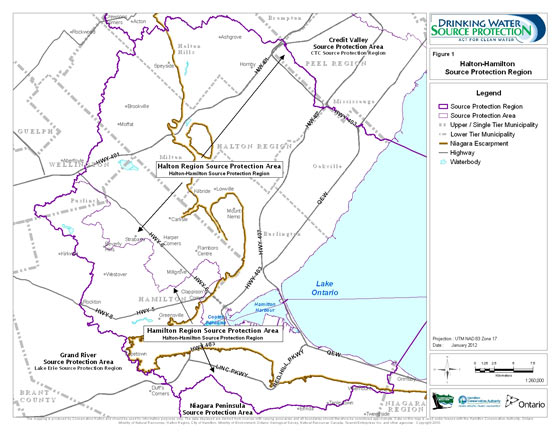
CTC (Credit Valley, Toronto and Region, and Central Lake Ontario) Source Protection Plan, and the Halton-Hamilton Source Protection Plan were developed by local municipal and community partners to protect the quality and quantity of water sources that supply municipal drinking water systems around Credit Valley, Toronto and Region and Central Lake Ontario, and Halton-Hamilton.and Halton-Hamilton Source Protection Plan, and the Halton-Hamilton Source Protection Plan
The following video presents Source Water Protection in Ontario:
- Distributed by Ministry of the Environment to Conservation Ontario & Conservation Authorities July 18, 2006.
Are you affected?
Also, Ontario has a tool to help you screen whether or not a property may be subject to the Source Protection Plan Policies, at http://www.ctcswp.ca/are-you-affected/ .
- You may see all the policies and maps in the Approved Source Protection Plan.

NEWS RELEASE
Province Protecting Sources of Drinking Water in the GTHA
Ontario Approves Two More Source Protection Plans
August 14, 2015 1:30 P.M. Ministry of the Environment and Climate Change
Ontario has approved two plans to protect sources of drinking water in the Greater Toronto and Hamilton Area.

The CTC Source Protection Plan, and Halton-Hamilton Source Protection Plan, and the Halton-Hamilton Source Protection Plan were developed by local municipal and community partners to protect the quality and quantity of water sources that supply municipal drinking water systems around Credit Valley, Toronto and Region and Central Lake Ontario, and Halton-Hamilton. The plans set out actions to eliminate, manage or reduce potential risks to these drinking water sources.
Many municipalities in the Greater Toronto and Hamilton Area will now be responsible for:
- Creating management plans to reduce the risks associated with manure, biosolids, livestock grazing, and commercial fertilizers
- Providing information to the community on best practices for maintaining septic systems as well as handling, storing and applying commercial fertilizers, pesticides, and road salt
- Developing or updating water conservation plans to support future growth and development
- Improving partnerships to protect the Great Lakes.
The CTC Source Protection Plan, and the Halton-Hamilton Source Protection Plan will take effect Dec. 31, 2015.
Ontario has now approved 18 of 22 source protection plans from areas across the province, and expects to approve the remaining plans by the end of the year. Together those plans will cover areas where 95 per cent of province’s population live.
Protecting the province’s clean drinking water and the environment are part of the government’s plan to build Ontario up. The four-part plan includes investing in people’s talents and skills, making the largest investment in public infrastructure in Ontario’s history, creating a dynamic, innovative environment where business thrives, and building a secure retirement savings plan.
Quick Facts
- The Clean Water Act established 19 local committees across Ontario. Each committee developed science-based plans that address risks to the water that supply municipal drinking water systems.
- The Credit Valley, Toronto and Region, and Central Lake Ontario (CTC) make up one source protection region. The region has 27 municipal drinking water systems that serve approximately 95 per cent of the area’s 6.7 million residents.
- The Halton-Hamilton source protection region has 10 municipal residential drinking water systems – six draw from an aquifer, and four draw from Lake Ontario. Over 90 per cent of the area’s 900,000 residents are served by these systems.
- Earlier this year, Ontario introduced the proposed Great Lakes Protection Act, building on existing Great Lakes partnerships for joint action to fight climate change, reduce harmful algal blooms, protect wetlands and tackle other complex problems in the Great Lakes basin.
Additional Resources
“Few things are as important to our health as having safe water to drink. Ontario’s approach to protect drinking water has made our tap water among the best protected in the world. Protecting the sources of drinking water – our lakes, rivers and groundwater – is the foundation of our safety net.”
Glen R. Murray
Minister of the Environment and Climate Change
“The day our plan was approved was a proud one for our committee. We have worked collaboratively to develop policies to protect drinking water sources for the seven million people who depend on municipal water. Our drinking water sources are diverse — from Lake Ontario to rural wells, with quality and quantity challenges.”
Susan Self
Chair, Credit Valley, Toronto and Region and Central Lake Ontario (CTC) source protection committee
“I am very pleased with the approval of the source protection plan for the Halton-Hamilton Source Protection Region. A special thanks to the hard work of the committee members and the guidance from our dedicated staff in developing a science-based plan that will protect our municipal drinking water supplies now and in the future. Also, thanks to our partners at the ministry, municipalities and our community stakeholders. We look forward to working with our partners to implement the plan.”
Robert Edmondson
Chair, Halton-Hamilton source protection committee
——————————————————————
You may also want to know:
- Know The Glow: 4 Tips To Spot The Golden Reflective Glow In A Child’s Photo And Save His or Her Eyes
- You’re Invited: “Olympus Street Photography with Mike Boening” Seminar at No Cost in Toronto, Canada August 22, 2015 (FREE admission)
- Please Urge Ontario to Raise ODSP Rates: Join ‘Stroll & Roll to Freedom’ March on July 7, 2015 UPDATE: Due to unfavourable weather forecast, this event was postponed. The new date of the march will be determined)
- Olympus Europe Invites You: Olympus Photography Playground at No Cost in Munich 25 Aug. – 20 Sept. and Vienna 25 Sept. – 4 Oct. 2015: Borrow the OM-D Camera at No Cost (FREE admission + FREE loan of camera)
- You’re Invited: “Home Field Advantage: Toronto’s Summer Sporting Sites” Exhibition of Historic Photographs Runs to Sept.26 at No Cost: To Celebrate TORONTO 2015 Pan Am/Parapan Am Games July 10 – Aug.14 (FREE Admission for Exhibition)
- Please Help Create the World’s Largest Marine Sanctuary in the Pacific: Petition Before Aug.11, 2014
- McAfee: Superstar Soccer Players’ Screensavers and “Skills” Video Downloads are Risky to Search for Online (McAfee’s FREE SiteAdvisor)
- You’re Invited: Take Home and “Test Drive” a Leica M Camera System & Two Lenses Overnight @ No Cost: Leica Store Bellevue in Washington, USA (FREE Test Drive program)
- Newseum’s ‘Reporting Vietnam’: New Exhibit of Powerful Photos & News Footage for the 50th Anniversary of the Vietnam War: May 22, 2015 – Sept. 12, 2016 (in Washington, D.C., USA; Kids’ Admission is FREE from July 1 to Sept. 7, 2015 )
- You’re Invited: Camera Obscura at The Photographers’ Gallery (FREE admission in London, UK)
- Panasonic + UNESCO: Beautiful 2015 World Heritage Calendar App for PCs & Tablets in Five Languages (FREE App)
- Stratasys’ New Recycling Program of 3D Printing Material Canisters & Cartridges for North American Customers Starts Today: Waste Disposal at No Charge (FREE disposal & recycling program)
- Panasonic Will Share Intellectual Property to Speed Development of Internet of Things (IoT) Software & Services (Panasonic formally pledges to provide royalty-FREE access to software, patents and experience from its product ecosystem)
- Leica: M Magazine App is Available at No Cost & M Magazine No. 2 is Also Available: Dedicated to M Photography Via the Leica M Camera, Presenting Pictures Taken by Renowned Photographers (FREE M Magazine App)
- UrtheCast’s High-Resolution Camera on the ISS Captured & Released the World’s First Full-Color HD Videos of London, Boston and Barcelona from Space (UrtheCast Corp., the Earth Observation (EO) company, aims to open the world to anyone with an internet connection: FREE)
- Photography Copyright Kit (FREE)
- Nikon Canada Invites Canadian Residents to Nikon Image Space: An Online Service for Sharing Photos or Recording Memories (FREE online service for all Canadian residents to share & record images: FREE two GB of storage for everyone and Nikon camera owners get an extra FREE 18 GB of storage.)
- New NIKON IMAGE SPACE App Renewal at No Charge: Benefits Include Seeing Images Larger & Browsing Images Stored on Your Smart Device (FREE online photo sharing service + FREE renewal of smart device app for “NIKON IMAGE SPACE”)
- Canon’s Cloud-based Image Management Service, irista: No Cost for Up to 15GB + New Updates are Now Live (FREE 15GB of cloud storage space with full irista functionality)
- Canon Europe Acquires Lifecake – Baby Photo Timeline: A Photo-sharing App for Families to Create Photo & Video Timelines (Lifecake is available FREE for iPhone, iPad and Android)
- You’re Invited to the New Leica Fotopark: A Photo Platform for Passionate Photographers to Discover, Exchange, Organise, Create [Registration on www.leica-fotopark is FREE, as is the use of the platform for data volumes of up to ten gigabytes (GB)]
- You’re Invited: Download Leica Fotografie International App for iPhone, iPod Touch, iPad and Android
- Scarborough Subway Project Assessment-Line 2 Extension: Public Consultations Jan.31 & Feb.2, 2015 + Online Feedback
- Panasonic’s Medical Delivery Robot “HOSPI” in the “Center for Advanced Medical Robotics” in Thailand
- Celebrate: Fort York Visitor Centre (five new exhibitions inside the new Visitor Centre in 2014 – 2015)
